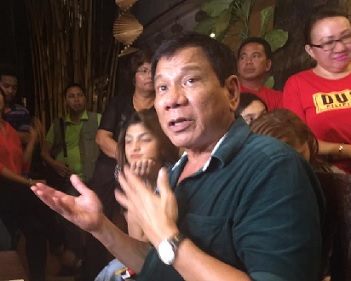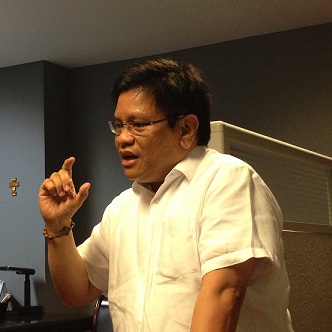Putanginas are staple in incoming president Rodrigo Duterte’s language.
His supporters love it. Mas malutong ang mura, mas malakas ang palakpak. Those were in rallies during the campaign. If parents brought along their children to those events, that was their sole responsibility to expose their children to those kind of gutter language.
In new reports of those rallies, print media don’t spell out the whole words. In TV and radio news reports, where they have time to edit the video, the curses are blipped.
It’s a different situation now that Duterte has won the election. His press conferences, even in the middle of the night or in the wee hours of the morning are aired live with his putanginas heard loud and clear.
The Movie and Television Review and Classification Board has been asked if the President is subject to their regulation. MTRCB chair Eugenio Villareal’s answer: “No.”
Of course. In the first place, why would a government agency under his office regulate him? Besides, he was elected by 16 million people aware of his foul mouth. Let him be. The Filipino people, even those who did not vote for him, would just have take him for what he is.
Here’s the statement of the MTRCB:
“In response to queries over media, the MTRCB officially informs the public that under Section 7 of Presidential Decree No. 1986, and its implementing rules and regulations, the agency’s jurisdiction does not cover “newsreels, i.e. straight presentation of events (which depict actualities) or straight news reporting. Examples are live media briefings or conferences, such as the recent evening media conference of the incoming Chief Executive, and on-the-spot news like a running reportage of a hostage crisis.
“In not subjecting straight news to MTRCB jurisdiction, the law clearly intended to give premium to the right to free speech and expression, and freedom of the press as well as the public’s right to information.
“ Latitude is given therefore to our television networks to show, say, the determination of firefighters to enter a burning house, the dispersal of a riot, or the anger and frustration of a public official over the alleged failure of law enforcers to curb the distribution of illegal drugs.
“The public is entitled to know not only what is happening, but also how much public servants care for them.
“As a matter of law and policy, the MTRCB respects and supports the right as well as duty of television networks to self-regulate in regard to straight news. The MTRCB notes that both the Kapisanan ng Mga Brodkaster ng Pilipinas (KBP) and individual networks have their own self-regulatory and ethical guidelines for the purpose.
“This came to light, for instance, during the inquiries in the 2010 Rizal Park hostage-taking crisis. Our networks will always have to balance freedom of the press—and many times together with the individual freedom of expression of the subject of the news, on the one hand, with constitutionally accepted limitations such as danger to national security or the right to privacy, on the other.
“The MTRCB is aware of the challenges of ‘as it happens’ reporting, including the need to authentically show events of national importance or to deliver the message of those who form public opinion, even if this will carry strong images or language. Thus, pursuant to its developmental mandate, the MTRCB has regularly endeavored to help networks by lending academic or expert resources for talks and conferences, and increasing public awareness on the matter through the agency’s Matalinong Panonood campaign.
“The MTRCB must clarify though that straight news are different from’ public or current affairs’ programs which analyze the news or express opinions. The latter, which ‘treat of the news’ and present commentaries on it are under MTRCB jurisdiction, as affirmed by the Supreme Court in the 2005 case MTRCB vs. ABS-CBN, et al. (G.R No. 155282, 17 January 2005).”




